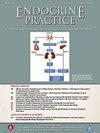Assessing Changes in Nonspecific Symptoms After Parathyroidectomy for Primary Hyperparathyroidism Using a Smartwatch
IF 3.7
3区 医学
Q2 ENDOCRINOLOGY & METABOLISM
引用次数: 0
Abstract
Objective
Parathyroidectomy (PTX) is indicated in primary hyperparathyroidism (PHPT) with osteoporosis or nephrolithiasis. There is not a uniform consensus on the benefit of PTX for nonspecific symptoms, but patient-reported questionnaires have demonstrated improved quality of life (QOL) afterward. This study aimed to evaluate physical activity and sleep after PTX using smartwatch technology.
Methods
A prospective study of consecutive patients undergoing PTX for PHPT from August 2022 to July 2023 was conducted. Each patient received a smartwatch to continuously track physical activity and sleep, starting 1 month before to 6 months postoperatively. Euthyroid patients undergoing thyroidectomy served as controls. A disease-specific QOL questionnaire was completed at baseline and 6 months. Data were compared within and between groups using linear mixed effect models.
Results
Forty-five patients were enrolled (PTX = 36, thyroidectomy = 9). The PTX group showed higher proportion of light sleep (68% vs 60%, P = .006), and a lower proportion of deep sleep (14% vs 18%, P < .001) when compared with the thyroidectomy group before surgery. After patients with PTX showed improvement in the QOL questionnaire (–16.0, P < .001) but there were no significant changes seen in the overall smartwatch physical activity or sleep patterns. However, improvements in the mood and sleep subcategory of the QOL questionnaire were associated with more deep sleep and lower number of nighttime awakenings.
Conclusion
Patients with PHPT seem to have worse sleeping patterns at baseline. Significant improvement after PTX can be seen using QOL questionnaires that are associated with sleep smartwatch data.
使用智能手表评估原发性甲状旁腺功能亢进患者甲状旁腺切除术后非特异性症状的变化
目的:原发性甲状旁腺功能亢进症(PHPT)合并骨质疏松或肾结石时,应行甲状旁腺切除术(PTX)。对于PTX治疗非特异性症状的益处,目前还没有统一的共识,但患者报告的问卷调查显示,PTX治疗后的生活质量(QOL)得到了改善。这项研究旨在利用智能手表技术评估PTX后的身体活动和睡眠。方法:对2022年8月至2023年7月期间连续接受PTX治疗的PHPT患者进行前瞻性研究。从术前1个月到术后6个月,每位患者都接受了智能手表,以持续跟踪身体活动和睡眠。接受甲状腺切除术的甲状腺功能正常的患者作为对照组。在基线和6个月时完成疾病特异性生活质量问卷。采用线性混合效应模型对组内和组间数据进行比较。结果:纳入45例患者(PTX=36,甲状腺切除术=9)。PTX组轻度睡眠比例较高(68% vs 60%, p=0.006),深度睡眠比例较低(14% vs 18%)。结论:PHPT患者的睡眠模式在基线时似乎更差。使用与睡眠智能手表数据相关的生活质量问卷,可以看到PTX后的显著改善。
本文章由计算机程序翻译,如有差异,请以英文原文为准。
求助全文
约1分钟内获得全文
求助全文
来源期刊

Endocrine Practice
ENDOCRINOLOGY & METABOLISM-
CiteScore
7.60
自引率
2.40%
发文量
546
审稿时长
41 days
期刊介绍:
Endocrine Practice (ISSN: 1530-891X), a peer-reviewed journal published twelve times a year, is the official journal of the American Association of Clinical Endocrinologists (AACE). The primary mission of Endocrine Practice is to enhance the health care of patients with endocrine diseases through continuing education of practicing endocrinologists.
 求助内容:
求助内容: 应助结果提醒方式:
应助结果提醒方式:


